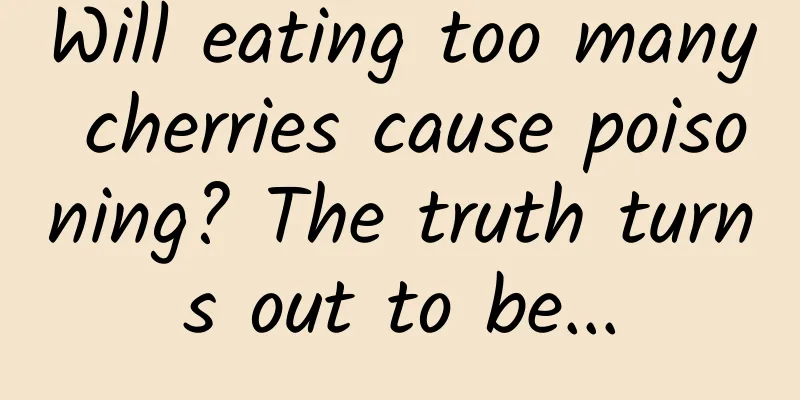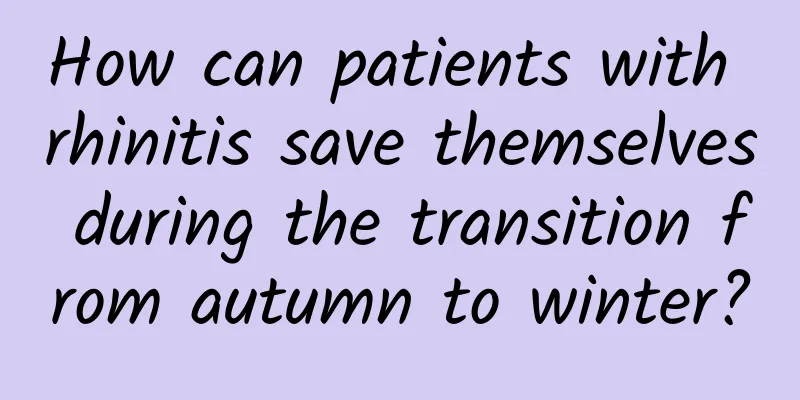Will eating too many cherries cause poisoning? The truth turns out to be...

|
gossip "Eating too many cherries can cause poisoning!" There has been a rumor circulating on the Internet that eating 5 cherries can cause hydrogen cyanide poisoning. Rumor Analysis This statement is not rigorous. Cherries do contain toxic ingredients, but the amount is so small that it would not cause poisoning if eaten normally. And the toxic substances are basically in the core, which most people cannot bite open, break, or eat. As the Spring Festival approaches, cherries are undoubtedly one of the most popular fruits. They are bright in color, juicy, thick, sweet and refreshing, and are loved by many people. Some netizens said that eating too many cherries can lead to iron poisoning and cyanide poisoning. Previously, it has been circulated online that eating 5 cherries will lead to hydrocyanic acid poisoning. What is cyanide? Can cherries still be eaten? Image source: Weibo screenshot Will eating too many cherries cause iron poisoning? Iron poisoning is caused by excessive iron intake. Data show that acute iron poisoning can occur when the iron intake reaches and exceeds 20 mg per kilogram of body weight at a time . For an adult weighing 60 kg, this is approximately 1,200 mg of iron. However, the iron content of cherries is not rich, only 0.36 mg/100 g . To reach the amount of iron poisoning, you need to eat about 333 kg. It is impossible for a normal person to eat so much at one time. Copyrighted stock images, no reproduction is authorized In addition, we should know that the iron content of the Chinese cabbage we often eat now is 0.8 mg/100 g. So, if you are worried about iron poisoning from eating cherries, then doesn't that mean you can't eat Chinese cabbage? Will eating too many cherries lead to cyanide poisoning? Eating too many cherries can also lead to cyanide poisoning. Is there really cyanide in cherries? Cyanide refers to a compound with a cyanide group (CN), whose structure consists of a carbon atom and a nitrogen atom connected by a triple bond. There are three types of cyanide that are truly highly toxic: sodium cyanide (NaCN), potassium cyanide (KCN), and hydrocyanic acid (HCN). Cyanide inhibits cellular respiration and is therefore harmful to humans and animals. Symptoms of acute cyanide poisoning in humans include vomiting, nausea, headache, dizziness, bradycardia, convulsions, respiratory failure, and ultimately death. For example, the lethal dose of potassium cyanide is between 50 and 250 mg, which is about the same as the lethal dose of arsenic (As2O3). Cyanide in plants usually exists in the form of cyanogenic glycosides. The seeds of many Rosaceae plants contain cyanogenic glycosides, such as peaches, cherries, apricots, plums, etc., and the kernels of cherries do contain cyanogenic glycosides. However, the flesh of these fruits does not contain cyanogenic glycosides. Hong Kong Food Research Centre shows that cherry kernels may contain cyanogenic glycosides Moreover, cyanogenic glycosides themselves are non-toxic. It is only when the plant cell structure is destroyed that the β-glucosidase in the cyanogenic plants can hydrolyze the cyanogenic glycosides to produce toxic hydrogen cyanide, which can cause acute poisoning in humans. So, how much cyanide is there in a cherry pit? At present, more than 50 kinds of cyanogenic glycosides have been discovered in the world, among which the most famous is amygdalin. In the TV series "The Legend of Zhen Huan", Concubine An finally committed suicide by eating bitter almonds because cyanogenic glycosides hydrolyzed into hydrocyanic acid. However, cases of cyanide poisoning caused by cherry kernels are almost unheard of, mainly because the content varies greatly. The content of cyanogenic glycosides in bitter almonds is about 2%~4%, which is a relatively high content of cyanogenic glycosides in the Rosaceae plants. If converted into hydrogen cyanide, it can contain several milligrams per gram. As for other Rosaceae fruit seeds, the cyanogenic glycosides are much lower. For example, the cyanogenic glycosides in each gram of cherry kernels are only about a few dozen micrograms after conversion to hydrocyanic acid, which is a few hundredths of that in bitter almonds. In addition, people generally do not intentionally eat cherry kernels, so cherry kernel poisoning is very rare. The content of cyanogenic glycosides in common foods. The content of cyanogenic glycosides in cherries is extremely low The dose of hydrocyanic acid that causes poisoning in humans is about 2 mg per kilogram of body weight. The online claim that eating 5 cherry kernels can cause poisoning is actually very unrealistic. The kernel of a cherry is only a few grams, which is less than a few milligrams of hydrocyanic acid at most. It can be seen that even if there are cyanogenic glycosides in cherry kernels, they are very rare, and not all of the cyanogenic glycosides eaten can be converted into hydrocyanic acid, so the possibility of causing poisoning in humans is really too small. Can I still eat cherries with confidence? Although cyanide is poisonous, don't panic too much. First of all, cyanogenic glycosides themselves are non-toxic. It is only when the plant cell structure is destroyed that the β-glucosidase in the cyanogenic plants can hydrolyze the cyanogenic glycosides to produce toxic hydrocyanic acid. Hydrocyanic acid can cause acute poisoning in humans. The cyanogenic glycosides in cherries are all in the cherry pits, which most people cannot bite open or break, and will not eat. Secondly, cyanogenic glycosides are also easy to remove. Since cyanogenic glycosides are unstable to heat, thorough heating is the most effective way to remove cyanogenic glycosides. Studies have found that boiling can remove more than 90% of cyanogenic glycosides. At present, the general international recommendation is not to eat these foods containing cyanogenic glycosides raw. For consumers, the simplest way is to avoid eating the core of the fruit . As long as you don't deliberately chew the seeds in the core, the possibility of cyanogenic poisoning from eating fruit is almost non-existent. Besides, the cherry flesh is so delicious and the pit is so unpalatable that most people won’t eat it. How to avoid cyanide poisoning? 1. Try not to eat foods containing cyanogenic glycosides raw, such as bamboo shoots, cassava, ginkgo nuts, etc. If you want to eat them, try to cut them into small pieces and boil them in boiling water before eating. Common foods containing cyanogenic glycosides also include fresh bamboo shoots, cassava, ginkgo nuts (gingko nuts) and some beans (such as lima beans). In 2008, the Hong Kong Food Safety Center measured the cyanide content in common edible plants in Hong Kong. The test results found that the cyanide content of bitter almonds (Apricot kernels), bamboo shoots, cassava and flax seeds samples ranged from 9.3 to 330 mg/kg; the cyanide content of bitter cassava was higher than that of sweet cassava; the cyanide content was distributed differently in fresh bamboo shoots, with the highest cyanide content in the tips of the shoots (120 mg/kg); the cyanide content in bamboo shoots and cassava products was lower, ranging from never detected to 5.3 mg/kg. 2. Do not eat or chew the seeds and cores of fruits such as apples, plums, apricots, and cherries. Looking in the mirror of rumors These rumors are more likely to spark discussion and spread quickly through scientific packaging, exaggeration of risks, blurring concepts, and using ingredients that are familiar to the public. For example, the use of medical terms such as "iron poisoning" and "cyanide poisoning" makes the content appear professional and credible, which can easily mislead the public, especially those who are not familiar with medical knowledge. In addition, the rumor directly links the small amount of iron and cyanogenic glycoside (a naturally occurring substance) contained in cherries with poisoning, exaggerating the risk. The rumor implies that "the high iron content in cherries" and "the risk of cyanide poisoning" can directly cause health hazards, but does not explain the actual amount and critical point of intake, blurring the difference between "excessive" and "normal intake", and logically replacing the concept. When faced with such rumors, we should remain rational, consult authoritative popular science content to verify the truth, not blindly believe or spread them, and cultivate scientific cognitive abilities. References [1]Bolarinwa, et al. Amygdalin content of seeds, kernels and food products commercially-available in the UK. Food Chem. 2014;152:133-9. [2]Cressey P, Saunders D, Goodman J. Cyanogenic glycosides in plant-based foods available in New Zealand. Food Addit Contam Part A Chem Anal Control Expo Risk Assess. 2013;30(11):1946-53. [3]FSANZ. SURVEY OF CYANOGENIC GLYCOSIDES IN PLANT-BASED FOODS IN AUSTRALIA AND NEW ZEALAND 2010-13. [4] Hong Kong Centre for Food Safety. Risk Assessment Studies. Report No. 27. Natural Toxins in Food Plants. [5] Hong Kong Centre for Food Safety. Food Safety Focus (Issue 110, September 2015). Cyanide and Food Safety. [6]Michal Voldrich, et al. Cyanogenesis in Canned Stone Fruits. Volume 57, No. 1, 1992, JOURNAL OF FOOD SCIENCE- 161-163 Planning and production Author: Ruan Guangfeng, Deputy Director of Kexin Food and Health Information Exchange Center Review | Zhong Kai, Researcher at the National Food Safety Risk Assessment Center Planning丨Fu Sijia Editor: Wang Mengru Proofread by Xu Lailinlin |
<<: Can eating more carrots cure myopia?
>>: Can drinking water with meals cause indigestion?
Recommend
Gynecological physical therapy side effects
Traditional treatments for cervicitis, such as mi...
Can pregnant women eat barbecued lamb skewers?
After pregnancy, the mother will immediately beco...
Can pregnant women get massage?
Nowadays, many pregnant women know how to take ca...
How do women determine whether menopause has arrived? This comparison table is very scientific
Menopause is a special period in women's live...
What are the symptoms of uterine fibroids
What are the symptoms of uterine fibroids? Uterin...
Does a 6 cm uterine fibroid require surgery?
Uterine fibroids are a gynecological disease that...
What is the importance and significance of learning etiquette? Basic etiquette at the Chinese table
In ancient my country, there were "five ritu...
Bloody vaginal discharge after sex
There are many things about women's bodies th...
Treatment of cervical ectropion
There are many kinds of problems with the cervix....
Can I sit after a miscarriage?
The improvement of abortion technology has greatl...
Can plasma cell mastitis turn into cancer?
If a woman's breasts have any abnormalities, ...
Acne on the chest and back of women
Many people say that it is very common to get acn...
Is it normal for the follicle to be 21x15 and not round?
Occult eggs are also a symptom of poor uterine de...
What is the cause of the particles on the vaginal wall?
The presence of particles on the vaginal wall may...
Women's menstrual period is best at 35 years
As we all know, women have a special period every...









